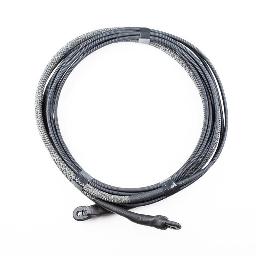When it comes to furling cables, custom top-down cables (for loose luff, asymmetrical gennakers) and bottom-up cables (for code zeros and staysails) can sometimes be expensive. For small to medium sized racing and cruising sailboats (up to 45ft), torsion rope or furling rope can often be a viable and cost-effective alternative for performance furling systems.
Thick, dense and resistant, torsion rope is a high-performance composite cable which is specifically designed to provide maximum torsional stiffness, whilst remaining flexible enough to be stuffed into a sailbag after use. As a result, torsion rope is great for high speed furling, ensuring fast torque transmission along the cable from the tack to the head of the sail.
Furling Rope Types
At upffront we distinguish between:
Torsional Cables - which are made to a specific length, in the factory, by winding high performance single, fibre tows (commonly K49, SK99 or PBO) around two end thimbles
Torsion Ropes - which are supplied by the manufacturer, in long lengths on a reel, and can be finished to the correct length on site, yourself or by a rigger / sailmaker
To produce a finished torsion rope, the cable is cut from a roll and needs to be terminated, at the required custom length, around a thimble at each end (to fit your furling unit/swivel). Due to the nature of the torsion rope, it is impossible to splice and the ends of rope are commonly secured with a metal clamp.

However, using a metal clamp as the termination method has disadvantages. Heavy and bulky, it is possible the cumbersome clamp could catch your sail – or possibly even tear it – in addition to being a real snag hazard for sheets and lines. What’s more, in our view the use of metal clamps, on a high-performance composite material, is archaic – and doesn’t align with upffront.com’s continued passion for lighter, faster, and safer sailing.
One of our preferred suppliers, Kohlhoff Rigging, are making waves in torsion rope innovation, inventing a truly unique, modern, soft solution that has been well received and endorsed by industry professionals across Germany and Northern Europe.
Instead of a clamp, their progressive ‘S-Splice’ termination makes use of the simple, but highly effective, Chinese finger trap principle.
Similar to the premise behind the Cousin Trestec Constrictor,the braided textile sock constricts, utilising friction, to keep the ends of the torsional rope in place around the thimbles. In addition to the textile sock, the cable’s Polyester and Dyneema covers are also glued with a special PU adhesive, ensuring maximum stability and durability.
Further, the ends of the torsion rope, bound by the textile sock, are tapered thus creating a streamlined transition with no hard edges (unlike a cable with a metal clamp). Consequently, the cable is less likely to get caught on sailcloth, lines or sheets - plus the tapered edge can easily go inside the sail luff pocket.
Benefits of this 'braided sock' termination method, in comparison to a metal clamps, include: lower profile, lightweight, flexible and soft – thus meaning it is kinder on the sails.
On top of all this, the standard thimble used by Kohlhoff Rigging is a Loop Product, purpose-built for this technique. This thimble has an additional hole which the braided cover travels through, meaning it is impossible for the thimble to twist out of the eye in the torsion rope, which can be an issue with other methods.
S-Splice Torsion Rope
The Kohlhoff Rigging S-Splice has been fully load-tested and exhibits excellent grip (due to the braiding angle of the cable jacket which is optimised for grip and anti-twist), good breaking strength and the special aramid cover prevents slipping of the splice and ensures optimum torque transmission.
If you have any questions about torsion ropes, please feel free to email us at [email protected], or click the link below to see our full range:


Torsion Rope or Furling Rope – What’s an S-Splice!?